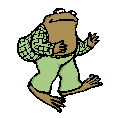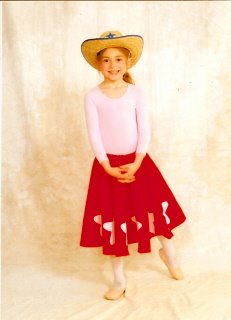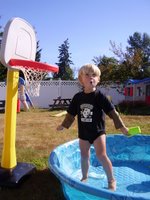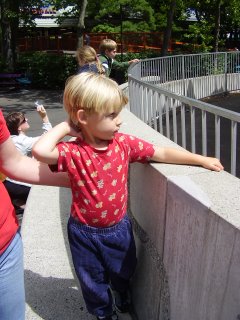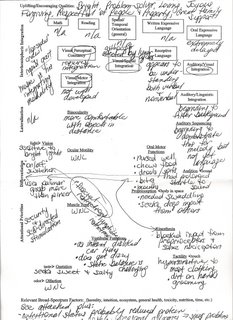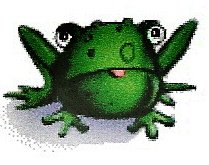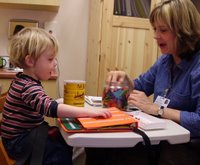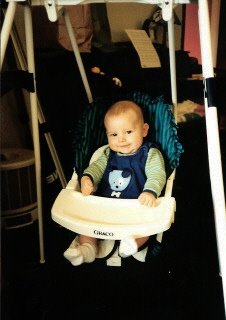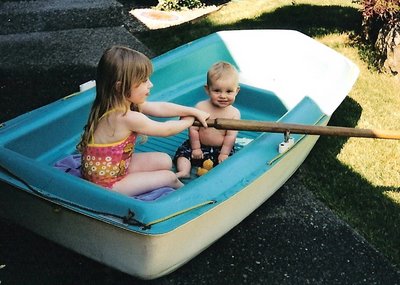Little Frog had appointments with Rosemary White, his OT and our DIR Coach, and Judith Bluestone from HANDLE in Seattle last weekend. We spent the night in Seattle and made a mini vacation out of it. Little Frog did remarkably well at both appointments and seemed to enjoy the attention. I think it was also a treat to have mom and dad all to himself for two whole days.
Rosemary has been my touchstone when it comes to Little Frog's progress for several reasons. She is an amazing therapist with very strong credentials having studied with Jean Ayers, Stanley Greenspan and Serena Wieder. She is a certified DIR therapist and instructor who sees clients and lectures all over the world. Of all of our various therapists and professionals, she has the depth of experience and can compare Little Frog and his progress with many other children to give us an idea of how he is doing. Because she is several hours away from us, we only see her every three months which gives her a different persepctive on Little Frog. She also has a wonderful rapport with Little Frog and with her other clients. Her Australian accent has captivated Little Frog from the beginning. Daddy frog used to imitate it to get Little Frog's attention. I hear her voice in my head as I apply the DIR principals and techniques she's taught us. We've been told that we, as a family, are very good at DIR. But there is a magic quality that we always achieve in a session with Rosemary that can be very illusive at home. We apply the techniques and we get the results, but it is at a much slower pace. When we work with Rosemary, Little Frog always shows us how much further he can go under the right circumstances.
This session, Rosemary coached us through examples of letting Little Frog make his intentions clear and keeping him in the interaction even when he begins to physically pull away. She pointed out that this time, he did not fully disengage, but remained tuned into what we were doing even when he needed to take a break. We were able to use a few more words and big motions to keep his attention. We model from a distance when he pulls away, but we also slow way down to give him more time to show us his intent. We experienced this rather dramatically on two occasions during his session. When Little Frog indicated he wanted more wheat thins, instead of simply responding his sign for more or following his modified point, we moved the crackers to a high shelf and played that they were out of our reach. We worked with Little Frog to come up with a plan to get to the crackers. This involved finding large cushions we could stack to get higher. Later we enlisted the help of a dog puppet who was able to reach the top shelf. Finally we worked on how Little Frog could climb on mom or dad's back to get to the top shelf - when this was successful, we did a victory lap with giggles and happy shouting from atop mom or dad. Not long ago, not getting the cracker right away would have been the end of Little Frog's tolerance for the interaction. This time he stuck with us through the long sequence and ultimately, the interaction became more important than the cracker. Little Frog decided that the victory lap was much better than crackers. Suddenly he was looking for methods to show his intent to get a ride. We kept him in the moment from one activity right into another.
Little Frog also discovered, when dad slowed down and waited for him to show his intent, that it is fun to have control of a situation. Little Frog wanted tickles and raspberries from dad. Rather than just giving him another when he signed more, Dad moved very slowly and kept stopping and asking "what now?" Or "where do you want a tickle?" Little Frog had to physically direct dad's head or hand to the spot where he wanted the tickle. Little Frog is still feeling the "high" of this control and wants to engage in this play again and again.
At the HANDLE appointment, we discussed his program and his response to everything so far. Judith seemed pleased with his progress to date. We modified a few of the exercises - such as letting him do his turtle over a surface other than my back, and adding a simultaneous tapping of his left and right hands with his left and right feet during the accentuated stomp. She also added a few exercises including some alphabet work that Little Frog is really enjoying.
Little Frog was very happily exploring the room by climbing on a chair to the window sill and onto a table. He was acting very stealthy about the whole process while watching us to see if we were watching him. Dad said he moved like a big cat and Judith asked him if he thought he was a panther. At this, Little Frog stopped what he was doing and gave Judith, then the rest of us, a very happy, proud, knowing look as if to say "why yes, Judith, I am a panther - thanks for finally noticing". We played with the panther idea, naming all of the other animals Little Frog had traits in common with - a cobra when he wound himself around mom's neck, a bat when he hung upside down and sensed movement from across the room, a frog when he swims in the pool, etc. He seemed very attentive to these ideas and happy with the game.
Judith suggested we draw shapes and letters on Little Frog's back with our fingers - identifying them after we drew them. He went to each person to have them draw something different for him. We plan to expand this exercise giving Little Frog cards he can give to request different shapes, letters or numbers. Later we plan to draw the shape, letter or number and ask Little Frog to give us the card with the item we just drew on his back. Judith also chanted the alphabet and the letter sounds to him as we did the accentuated stomp. He really paid attention and asked for more of this. "A says ah, B says buh, C says kuh, D says duh, . . ."
Since returning from Seattle, Little Frog has been easily agitated (lots of screaming, pinching, frustration), but he has also been really engaged for long periods of time. He is seeking us out for playtime. He is being very insistent and persistent in getting his ideas across. He ran back and forth while I read him a book. I thought I lost him and put the book down. A few minutes later, I found the book in the playroom where he had taken it to continue reading the story on his own. He has started saying "ug" to Daddy Frog with outstretched arms followed by a hug for dad. He has started saying "iss" to me and presenting his forehead for a pressure filled kiss. He is watching more TV - the programs, not just the theme music. He still wants a lot of water play on his own or with a partner. He has made new discoveries about how water moves in his pool - including his new favorite, stand on the edge of the pool and the water runs out of the pool over your feet.
Things we are noticing:
1. Lots of eye contact.
2. Longer time periods for problem solving.
3. More hints at words.
4. A lot of finger play -
touching individual fingers to his thumbs.
5. Better auditory processing -
can tell where sounds are coming from,
and can focus on one sound at a time better.
6. More self-correcting -
will stop mid arm bite and start to blow,
will stop just before pinching another child and pat
the child then move away.
7. Intensified pressure seeking -
seeks pressure from other people.
8. Slightly less drooling
(still likes to spit liquids, but seems to know he
is not supposed to do it in the house).
9. Still mouths, but also explores objects with his
hands and fingers.
Overall, I think we have made some progress over the summer. It will be interesting to see how the transition to school goes next week. I'm hoping to work with some of the para-educators to show them what we have learned from DIR and HANDLE.




